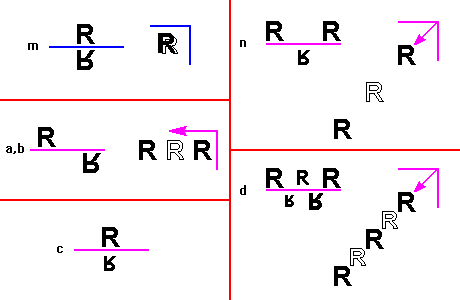
Steven Dutch, Natural and Applied Sciences, University of Wisconsin - Green
Bay
First-time Visitors: Please visit Site Map and Disclaimer. Use
"Back" to return here.
Start by considering the point groups and lattice types in two dimensions:
| Symmetry | Lattice Type |
|---|---|
| 1 | Parallelogram |
| m | Rectangle |
| 2 | Parallelogram |
| 2m = mm | Rectangle, Rhombus |
| 3, 3m | Hexagonal |
| 4, 4m | Square |
| 6, 6m | Hexagonal |
By combining the permissible point groups with their possible lattices, we find 11 of the 17 plane space groups. The remainder arise when we add glides to the patterns. Not all point groups are compatible with all lattice types. Groups cannot have a lattice with lower symmetry than that of the space group. A group can have a lattice with higher symmetry, but nothing new results: putting a 1-fold motif into a square lattice still results in a 1-fold space pattern, for example.
Similarly, in three dimensions we can combine the 14 Bravais lattices and the 32 point groups as shown here:
| Crystal Class | Bravais Lattices | Point Groups |
|---|---|---|
| Triclinic | P | 1, 1* |
| Monoclinic | P, C | 2, m, 2/m |
| Orthorhombic | P, C, F, I | 222, mm2, 2/m 2/m 2/m |
| Trigonal | P, R | 3, 3*, 32, 3m, 3*2/m |
| Hexagonal | P | 6, 6*, 6/m, 622, 6mm, 6*m2, 6/m 2/m 2/m |
| Tetragonal | P, I | 4, 4*, 4/m, 422, 4mm, 4*2m, 4/m 2/m 2/m |
| Isometric | P, F, I | 23, 2/m3* 432, 4*3m, 4/m 3* 2/m |
If we tally up the possible combinations, we get 66. Upon closer inspection, we discover that a few other variations are possible. For example, we can have 3, 4, or 6-fold symmetry with mirror planes along the edges of the lattice or bisecting its angles. There are a total of 73 space groups that arise from repeating a motif with one of the point group symmetries according to the possible Bravais Lattices. These are called the simple space groups.
In three dimensions, there are other possibilities. Not only can there be glides, but the orientation of the glide and its direction of translation can vary. In addition, there is a combination of rotation and translation called a screw axis. A screw axis is just what the name implies: an object rotates and translates along an axis in a helical pattern. Glides and screw axes raise the total number of all space groups in three dimensions to 230.
In all diagrams, the letter R is used as a motif, with larger letters closer and smaller ones more distant. Outlined R's mean we are viewing the back side of the motif. Overlapping solid and outlined R's are used to indicate a motif and its reflection in a mirror plane in the plane of the diagram.
 |
On the left in each diagram is the symbol and appearance of a mirror or glide plane seen edge-on. On the right is the symbol and appearance viewed perpendicular to the plane. Arrows show translation directions. |
a, b are glides parallel to the unit cell edges. We see the object alternating with its translated reflection.
c is a glide parallel to the third edge of the unit cell. Since all the figures (except isometric classes) view down this direction, there is no view perpendicular to the plane. The object and its reflection are translated along the line of sight, so we see the object, then its reflection translated away from us (hence smaller). More distant translations are hidden behind (beneath) the two images shown.
n is a diagonal glide, half a unit cell edge in each direction. In the view along the plane, additional images would continue to step down and to the left, but they are hidden behind neare images of the object.
d is like n in being a diagonal glide, but here the step is one quarter unit cell edge in each direction. Viewing along the plane we see four progressively more distant images of the object before the series in the neighboring unit cell begins.
Triclinic
and Monoclinic (2 and m) Space Groups
Monoclinic
(2/m) Space Groups
Orthorhombic
(222) Space Groups
Orthorhombic
(mm) Space Groups
Orthorhombic
(2/m 2/m 2/m) Space Groups (P Lattices)
Orthorhombic
(2/m 2/m 2/m) Space Groups (C, I and F Lattices)
Tetragonal
(4 and 4*) Space Groups
Tetragonal
(4/m) Space Groups
Tetragonal
(422) Space Groups
Tetragonal
(4mm) Space Groups
Tetragonal
(4*2m) Space Groups
Tetragonal
(4/m 2/m 2/m) Space Groups (P Lattices)
Tetragonal
(42/m 2/m 2/m) Space Groups (P Lattices)
Tetragonal
(4/m 2/m 2/m) Space Groups (I Lattices)
Trigonal
(3 and 3*) Space Groups
Trigonal
(32) Space Groups
Trigonal
(3m) Space Groups
Trigonal
(3*2m) Space Groups
Hexagonal
(6) Space Groups
Hexagonal
(6*, 6*2m and 6/m) Space Groups
Hexagonal
(622) Space Groups
Hexagonal
(6mm) Space Groups
Hexagonal
(6/m 2/m 2/m) Space Groups
Pm3*,
Pn3*
Fm3*,
Fd3*, Im3*
Pa3*,
Ia3*
P432,
P4232
F432,
F4132, I432
P4332,
P4132, I4132
P4*3m,
F4*3m, I4*3m
P4*3n,
F4*3d, I4*3d
Pm3m,
Pn3n
Pm3n,
Pn3m
Fm3m,
Fm3c
Fd3m,
Fd3c
Im3m,
Ia3d
Return to Symmetry
Index
Return to Crustal
Materials (Mineralogy-Petrology) Index
Return to Professor Dutch's Home Page
Created 30 March 1999, Last Update 11 December 2001
Not an official UW Green Bay site